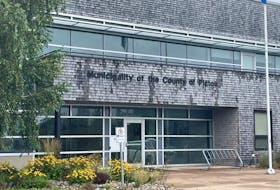KENTVILLE, NS - Consider it returning the favour to representatives of an Italian city that showed great kindness to a delegation from the Kentville area last year.
The West Nova Scotia Regiment Regimental Association (WNSRRA) recently held its 69th annual reunion, which was attended by two delegates from Castel di Sangro, Italy: writer and engineer Alessandro Teti and Nicola Buzzelli, who has an interest in history and served as an elected official in Castel di Sangro.
It was the West Nova Scotia Regiment that liberated the Italian city from German occupation in November 1943. Castel di Sangro officially twinned with Kentville in July 2017, hosting a huge celebration. Nine delegates representing Kentville and the WNSRRA visited Italy for the twinning ceremony, including WNSRRA president Ron Stonier and director Garry Randall.
Randall said the twinned communities have a lot in common, even comparable populations. He said the delegation members were all “treated like gold” and were presented with small plaques commemorating the occasion. Other events included special meals, tours of various sites where the West Novas fought, a visit to the Moro River Canadian War Cemetery, a parade and more.
Randall said the Italians did everything in their power to make the trip enjoyable for the Annapolis Valley delegates. Approximately 6,500 people live in the town but Randall said there must have been 10,000 who turned out.
“There was no mistaking we were there, every store had a sign,” Randall said. “The ceremony they had was just beyond belief, I have never been part of anything like that, ever.”
ALSO SEE:
IN THE THICK OF THINGS – WEST NOVA SCOTIA REGIMENT UNPACKS ARTIFACTS, MEMORIES AT NEW MUSEUM EXHIBIT
JOINING UP – WEST NOVA SCOTIA REGIMENT’S BUTTERWORTH TALKS ABOUT ARMY RESERVES
Teti and Buzzelli wanted to reciprocate with a visit to the Kentville area for the WNSRRA reunion in 2018. They visited Nova Scotia from Sept. 12 to 17 and were in Kentville from Sept. 14 to 16. Translators were on hand to help overcome the language barrier.
Randall said it was important to the visitors to take in some of the history of the West Novas, including visiting what was the Kentville home of F.H. “Hugh” Burns and his Steam Mill gravesite to lay poppies and wreaths. Burns led the West Novas in the attack against the Germans at Point 1009 in Castel di Sangro on Nov. 23, 1943. Burns’ son, Frank, who lives at the Wolfville Elms, also visited the cemetery for the occasion.
“They didn’t just drop a wreath and walk away and let the caretaker mow the lawn, they paused and they looked and they thought a lot while they were there,” Randall said.
Stonier said Burns’ grave and those of other regiment members in the cemetery were decorated with Nova Scotian, Canadian and Italian flags.
“It was an important thing for the Italians to be there at the gravesite of the man who led the attack,” Stonier said.
William Allen Benjamin, who was from Canning, was among the members of the West Novas killed at Castel di Sangro on Nov. 23, 1943. The Italian delegates had a chance to meet Benjamin’s nephew, Floyd Benjamin. Randall said a poignant moment came when Teti shook Benjamin’s hand and said, “I’m sorry.”
The Italian delegates visited the Macdonald Museum in Middleton where there is a permanent WNSR exhibit on display that includes William Benjamin’s war medals.
Some other local stops included a breakfast hosted by Kentville Mayor Sandra Snow at the Grand Street Inn and a lobster dinner at the Kings Arms Pub. It was the first time the Italian visitors had eaten lobster.
Stonier said having twinned with Kentville is a big deal for the people of Castel di Sangro but the general population here doesn’t recognize the significance as much as the Italians do. Initiatives such as promoting the twinning on Kentville’s town signs could serve to help raise awareness.
“It was our soldiers who were sacrificed on that raid. The platoon was annihilated essentially, the first guys on top of the hill,” Stonier said.
He said that the Nova Scotia delegation was treated so well in Castel di Sangro that it was important to reciprocate the show of good will. A former Commanding Officer of the West Nova Scotia Regiment, Stonier said he thinks it’s important for current serving members to meet the representatives of Castel di Sangro and to connect with the regiment’s history. He said perhaps a delegation could visit the Italian town in recognition of the 80th anniversary of the battle in 2023.
The twinning
Teti had initially contacted the WNSRRA several years ago seeking historical information on the regiment and those involved in the liberation effort for a book he was writing. He got the twinning initiative underway in 2016 when he brought a letter from Castel di Sangro Mayor Angelo Caruso to Kentville town council proposing the twinning. Caruso extended the offer based on strong historical and military ties.
“We’re the only Canadian infantry unit to get a battle honour for Castel di Sangro,” Randall said. “Those people were getting ready to be starved to death, very simple, and they didn’t care who got the Germans out of there. They were just happy that somebody did it.”
Randall said Teti had asked him if there were any living survivors from the battle at Castel di Sangro. Randall later learned that veteran Victor Dukeshire, who although he was well into his 90’s still attended WNSRRA reunions, had fought there. Randall let Teti know and, in 2016, Teti made the trip from Italy to attend the reunion, where he met Dukeshire and interviewed him for a video production.
Battle at Castel di Sangro
By Nov. 22, 1943, the 3rd Brigade had successfully cleared German outposts east of the Sangro River in Italy, with the exception of German troops holding out at the top of Point 1009, a steep hill in Castel di Sangro.
Brigadier Gibson, commanding the 3rd Canadian Brigade, and Lieutenant-Colonel Bogert of the West Novas were observing Point 1009 and decided on a one-company assault by “B” Company of the West Novas. Captain F.H. Burns was ordered to make his attack at 1 a.m. on Nov. 23.
However, the platoon had been lured into a trap.
In the darkness and rain, the Canadian company commander deployed two platoons to give covering fire from below and Lieut. J.B. “Blackie” Blanchard’s platoon rushed a cathedral at the top of Point 1009. Blanchard was fatally wounded, living long enough to order his men back.
A fog that rolled in with the approach of daybreak provided a cover for an escape, although several men broke arms and legs jumping off a steep ledge.
Randall said that from accounts that they have, there were four members killed, 10 wounded and 16 captured during the initial assault on the Germans at Point 1009.
As artillery duels raged all day on Nov. 24, members of the West Novas again went up Point 1009 using the bombardment as cover. One concentration on Point 1009 consisted of 5,000 rounds of gunfire in just half an hour.
It was discovered that the enemy had withdrawn from the plateau the previous night. The West Novas found three wounded men from its “B” Company in the cellar of the monastery who the Germans had left behind. Walls four feet thick had protected them from the artillery bombardment.
GO ONLINE:
For more information on the West Nova Scotia Regiment Regimental Association, visit the group’s Facebook page at https://www.facebook.com/wnsrra/.








